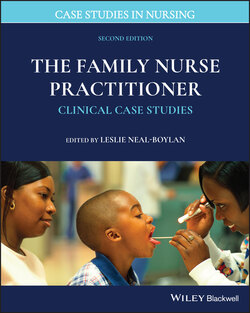Читать книгу The Family Nurse Practitioner - Группа авторов - Страница 48
ОглавлениеCase 5.6 Vaginal Discharge
By Betsy Gaffney, MSN, APRN, FNP‐BC
SUBJECTIVE
Nora, an 18‐year‐old college student known to this family practice office, presents with a complaint of “some spotting since my last period and a vaginal discharge.” Nora is home on a college break and states “I’m afraid I have an STD.” She relates that she has “been healthy” while at school “except for this problem” and that she “did not feel comfortable going to the university health center.” She denies any urinary burning or frequency. She denies any abdominal pain or pain with sex.
Past medical/surgical history: Negative with exception of tonsillectomy, age 7.
Medications: None.
Allergies: No known allergies.
Menstrual history: Menarche age 10 with regular 28‐day cycle with 3–5 days of bleeding. Last menses 3 weeks ago with intermenstrual spotting 2 times since then.
Sexual history (obtained using the CDC’s “5 P” approach):
Partners: Nora’s first sexual encounter was at age 16. She has had 4 encounters in the past 2 years with 2 different partners, with 2 encounters in the last 2 months.
Prevention of pregnancy: Nora was prescribed a triphasic oral contraceptive at age 16 but says “I stopped taking it after a few months and haven’t been on any since.” Her partners “use condoms once in a while.”
Prevention of STIs: Limited to inconsistent condom use.
Practices: Nora describes her encounters as limited to vaginal intercourse and “oral sex once in a while.” She denies anal sex.
Past history of STIs is negative.
OBJECTIVE
General: Anxious 18‐year‐old female in no acute distress. Well groomed with good hygiene. Cooperative.
Vital signs: Height: 5 ft 4 inches; weight: 112 lbs; BMI: 21.2; temperature: 97.8°F; B/P: 118/72; HR: 98.
Respiratory: Normal respiratory effort, CTA bilaterally.
Cardiac: Regular rate, rhythm. No murmurs, gallops.
Breasts: Tanner IV.
With Nora’s consent a pelvic exam was done.
Pelvic/Genital exam: No vulvar or vaginal lesions. Mucoid, nonodorous discharge was noted and vaginal and endocervical swabs obtained. Cervix appeared inflamed but was nonfriable and there was no cervical motion tenderness (CMT). Discomfort but no tenderness on bimanual examination.
CRITICAL THINKING
1 Which diagnostic studies should be considered to assist with or confirm the diagnosis?___Urine HCG___Nucleic acid amplification test (NAAT) for chlamydia___NAAT for gonorrhea___Wet mount (saline, KOH prep of vaginal secretions) to rule out coexisting infection___HIV‐1 antibody testing___Venereal Disease Research Laboratory (VDRL)
2 What is the most likely differential diagnosis and why?___Chlamydia (C. trachomatis)___Gonorrhea (N. gonnorhoeae)___Bacterial vaginosis___Trichomonas vaginalis___Pregnancy___HIV
3 What is the plan of treatment?
4 How should this patient be counseled regarding the prevention of STIs?
5 Is this patient at risk for HIV?
6 Should this patient be retested for cure after treatment?
7 Should this patient’s partners be treated?
